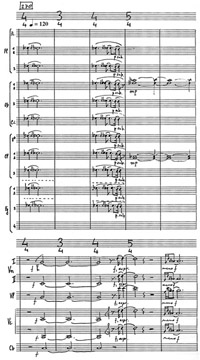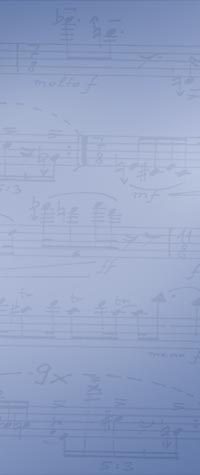
Remix, Redream, Reflight (2000)
for orchestra
- Instrumentation: 4,4,4,4, - 4,2,2,1 - 1 perc - strings
- Movements: 1
- Duration: 17'
- Commissioned by: Musica Viva München
- Premiere: 06.10.2000, Musica Viva München; Symphonieorchester des Bayerischen Rundfunks, Peter Rundel - cond.
- Publisher: Breitkopf & Härtel (hire material)
Program Note:
(CZ - stručný)
V první polovině skladby převažuje rozstříhaný a nově poslepovaný materiál historické hudby (remix). Představíme-li si to jako výtvarnou koláž, pak drásavá vzestupná glissanda dechového orchestru, jež narušují klid Mahlerových, Mozartových a Beethovenových harmonií, jsou jako tlusté tahy štětcem přes ni (redream – znovuprosněno, proměněno sněním). V další fázi historickou hudbu už docela vystřídá vzletná (reflight) kantiléna smyčců, trýznivě napínaná čtvrttóny. Směs, sen, vzlet!
Martin Smolka
(CZ - podrobnější)
Na Ježkově konzervatoři jsem zažil důkladnou přednášku o současné taneční hudbě vytvářené na počítačích, s ukázkami všech možných stylových odnoží a také technických zařízení. Porozuměl jsem tomu tak, že tvořivý DJ má v počítači celý rock a pop, příp. jazz a jakoukoli další hudbu, rozložené na součástky. Z těch součástek skládá koláže. Zvláště mě fascinovalo zařízení, které rovnou hraje, a tvůrce postupuje cestou odebírání.
Cestou domů jsem se bavil představou, jak by asi vypadala vážná hudba přepracovaná touto technikou. V duchu jsem lepil za sebe do smyček závěrečné akordy klasických a romantických symfonií a místo duc-duc tvrdil muziku typický šlágverk 19. století – velký buben, triangl a pár činelů.
Shromáždil jsem přes dvacet svých nejoblíbenějších partitur od Mozarta až po Brittena. Brzy jsem ale zjistil, že zrovna ty závěrečné akordy nezní nejzajímavěji a začal jsem pátrat uvnitř vět – nejprve mezi zvláštněji postavenými a instrumentovanými akordy a nakonec mezi průtažnými harmoniemi (mimochodem: vyňaty ze svého prostředí znějí jako Stravinský).
Orchestrální skladba, která pak vznikla, střídá dva typy hudby. Základní materiál prvního typu tvoří 4 mollové trojzvuky, jeden durový sextakord a jeden (měkce velký) septakord. Secco akordy v pořadí Beethoven, Berlioz, Franck, Kabeláč, Čajkovský, Mahler nastupují v rychlém sledu uvnitř dokola opakované repetice. Další vývoj a variační proměny této hudby provází různé druhy ubývání - repetice se postupně zkrátí z šesti na dva akordy, třetí a čtvrtá variace pracuje už pouze s množstvím obměn jediné harmonie.
Druhý typ hudby, klidnější, lyrický, přináší tři sledy převážně průchodných harmonií – z Mozartovy Jupiterské symfonie, z Beethovenova dechového oktetu a z Mahlerova Adaggietta z 5. symfonie. Nastupují prostřídaně (jeden akord z Mozarta, jeden z Mahlera atd.) a později jsou také rozvíjeny ubýváním (při novém uvedení akordu nějaký nástroj mlčí, z trojzvuku už je jen dvojzvuk apod.). Ale namísto variací prostupují tuto hudbu víc a více nové hudební prvky, tentokrát už volně fantazijní a v hudební řeči konce 20. století.
V první polovině skladby tedy převažuje rozstříhaný a nově poslepovaný materiál historické hudby (remix). Představíme-li si to jako výtvarnou koláž, pak drásavá vzestupná glissanda dechového orchestru, jež narušují klid Mahlerových a Mozartových harmonií, jsou jako tlusté tahy štětcem přes ni (redream – znovuprosněno, proměněno sněním). V další fázi historickou hudbu už docela vystřídá vzletná (reflight) kantiléna smyčců, trýznivě napínaná čtvrttóny. Zde už je historie přítomna jen v transformované podobě, v užití principů, jimž se Nová hudba druhé poloviny 20. století ostražitě vyhýbala. Je to velké kantabilní unisono smyčců (sedne tu žargonový výraz "stehno"), byť jinaké tím, že všichni včetně violoncell hrají v jedné oktávě; a princip citlivého tónu, který je vzkříšen pomocí čtvrttónů, vzpínajících se k očekávatelným tónům modální melodiky.
Jemnou pointou pro pozorné posluchače je závěrečný kvartsextakord, vypůjčený z konce 2. věty Beethovenovy sedmé, ale nakřápnutý mňouknutím pekingského operního gongu - souzvuk, který skladbu také odstartoval. Onen šlágverk 19. století jsem, věren principu odebírání, vypustil docela.
Martin Smolka (2005)
(EN)
When I taught at the Jaroslav Ježek Conservatory [a high school dealing mainly with pop and jazz music] my students made a brilliant presentation on contemporary dance music composed on computers presenting all possible style variations and technical equipment. I understand that a creative DJ has the whole rock and pop music, possibly jazz, decomposed in components in his computer. He composes new collages from them. I saw a fascinating device there: it produced music directly and the new piece of music was made by reducing sound elements.
On the way home, I was occupied with the idea how the classical music re-made using this method would sound. In my mind, I put the closing chords of classical and romantic symphonies into loops with typical drumming of the 19th century bass drum, triangle, and piatti due in the background in stand of the bam-bam.
I selected more than twenty of my favourite scores from Mozart to Britten. I found out early that the closing chords weren't the most interesting and I started to focus more on those in the middle of movements, first on chords built and instrumented in unusual way and finally on passing harmonies (apropos: extracted from the context they sound like Stravinsky).
Orchestral pieces composed according to those principles vary between two types of music. The first type is composed of four minor triads, one major sixth chord and one minor-major seventh chord. Secco chords in the order of Beethoven, Berlioz, Franck, Kabeláč, Tchaikovsky and Mahler repeat in quick sequences. Further development and variation changes od this music are based on reduction, where repetition is reduces from six to two chords, and the third and fourth variation work with multiple variations of one harmony.
The second type of music, more calm and lyrical, presents three sequences of mainly passing harmonies - from Mozart's Jupiter Symphony, Beethoven's Wind Octet and Adagietto from Mahler's Sth Symphony. They come one after another (one chord from Mozart, one from Mahler etc.) and they are further developed using reduction, where one instrument stays quiet by new introduction of the chord, so that triads become just dyads, etc. This music is then more and more interpenetrated with elements of musical language of 20th century and free fantasy.
Remix of historical music dominates the first part of this work. If it was a graphical collage, the ascending glissandi of wind orchestra, which disturb the peace of Mahler's and Mozart's harmonies, would be like strokes of a thick paintbrush over te (re-dream - changed by dreaming, re-dreamed). In the second part, the classical music is replaced by expressive cantilena of strings (re-flight), straines with quarter-tones. History is presented in a transformed way, i.e. in use of principles, which the New Music of the 20th century carefully evades. It is
1) a great cantabile unison of strings with the specification that all string instruments including violoncellos play in the register of one octave, and
2) the principle of the leading tone, sounding new thanks to the quarter-tones reaching the predictable tones of modal melodics.
The fine point for carefull listeners is the closing chord in its second inversion, taken from the end of Beethoven's Seventh Symphony, in this case cracked by meoving of Beijing opera gong, which was already heard at the beginning of this composition.
Martin Smolka (2005), translated by ?
(EN)
To say the truth, I’ve got sick of the contemporary music already. And so I attempted to solve an vexed question reminding a fairy-tail-riddle: How to stay composer and continue writing music but produce anything else than contemporary or new music?
Remix
In the beginning I had a lot of fun with such a concept: Let me recycle music, there is too much music attacking us all around in this world, anyway. Let me take the final secco-chords of the most beloved orchestra masterpieces, make a chain of them in a very fast speed and then make various loops of the chain, repeated many times. Let me arrange that way a meeting of my favourite masters, especially those who never could meet each other, e. g. Mozart - Berlioz - Mahler. Pairs of cymbals and bass drums would make a "19 century disco” background to it.
Redream
But later with a concrete material in hands I got far and far off the original concept. Another chords than the final ones and another tempi as well as another combinations emerged to be interesting. The work got amazing in the moment when the historical material began to loose its identity.
Reflight
Later the museum smell of the classics chords started to stifle me and I had to run out quickly to breathe in a fresh air (of imagination).
P.S.:
| Compositional techniques | - | Inspirations |
| Repetitions | - | DJ music |
| Extremely fast tempi | - | Laurel & Hardy |
| Mictrointervals | - | authentic folk music, blues |
| Transparent simpleminded form | - | principle version - refrain |
Martin Smolka (2000)
(DE)
Ehrlich gesagt, ich bin der zeitgenössischen Musik schon etwas überdrüssig geworden. Und so habe ich versucht, ein Problem zu lösen, das an die Rätsel in Märchen erinnert: Wie kann man Komponist bleiben und weiterhin Musikwerke schreiben, dabei aber alles andere produzieren als zeitgenössische oder Neue Musik?
Remix (Neu Mischen)
Zunächst hat mir folgendes Konzept eine Menge Spaß bereitet: Warum nicht Musik recyclen? Wir werden in dieser Welt ohnehin von zu viel Musik attackiert. Ich nahm die Schlussakkorde der beliebtesten Orchesterstücke, reihte sie in schneller Folge aneinander und gestaltete dann mehrere sich häufig wiederholende Schlingen aus dieser Kette. Auf diese Weise arrangierte ich ein Treffen meiner Lieblingskomponisten, besonders derer, die sich in der Wirklichkeit nie treffen konnten, so wie Mozart, Berlioz und Mahler. Die Klänge von Becken und Basstrommeln sollten für einen Disco-Hintergrund sorgen, der dem 19. Jahrhundert entstammt.
Redream (Neu Träumen)
Später jedoch, als mir das konkrete Material vorlag, habe ich mich immer weiter von meinem ursprünglichen Konzept entfernt. Andere Akkorde als die Schlussakkorde, andere Tempi, und andere Kombinationen stellen sich ebenfalls als interessant heraus. Das Werk wurde beeindruckend in dem Augenblick, als das historische Material begann, seine Identität zu verlieren.
Reflight (Zurückflüchten)
Später begann der Museumsgeruch der Klassiker mich zu ersticken und ich musste schnell hinausrennen, um frischen Wind zu spüren (im schöpferischen Sinne!).
Postskriptum:
| Kompositionstechniken | - | Inspirationsquellen |
| Wiederholungen | - | DJ-Musik |
| sehr schnelle Tempi | - | Laurel und Hardy |
| Mikrointervalle | - | authentische Volksmusik, Blues |
| Transparente, einfache Form | - | Strophe - Refrain |
Martin Smolka (2000)







 Listen to an mp3 excerpt
Listen to an mp3 excerpt